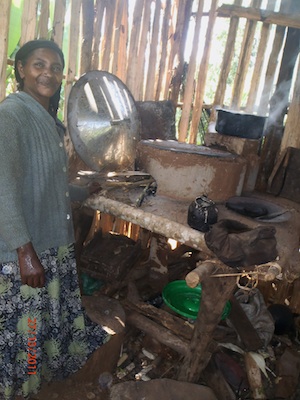Walderhaltung durch Holz sparende Öfen
 Kafa is the birthplace of wild coffee, News Archives, where it has been consumed for more than 1,000 Jahr. There are now close to 5,000 wild varieties of coffee in this biodiversity hotspot. A unique coffee culture is deeply ingrained in the Ethiopian economy and history. This culture is a key element of the participatory forest management scheme created in the Kafa Biosphere Reserve to avoid deforestation and boost economic development.
Kafa is the birthplace of wild coffee, News Archives, where it has been consumed for more than 1,000 Jahr. There are now close to 5,000 wild varieties of coffee in this biodiversity hotspot. A unique coffee culture is deeply ingrained in the Ethiopian economy and history. This culture is a key element of the participatory forest management scheme created in the Kafa Biosphere Reserve to avoid deforestation and boost economic development.
NABU (The German Nature and Biodiversity Conservation Union) and its partners have worked towards the preservation of these forests obtaining the establishment of the UNESCO Kafa Biosphere Reserve in June 2010 and implementing the project: “Climate Protection and Preservation of Primary Forests – A Management Model using the Wild Coffee Forests in Ethiopia as an Example“.
Das Projekt erreicht die Produktion und den Vertrieb von 11200 energiesparende Öfen den Bewohnern obwohl Kooperationsprojekt mit der Abteilung Energie. 70 arbeitslosen Jugendlichen ausgebildet wurden organisiert und ausgestattet und eingesetzt in 11 Produktion und 25 Sat-Websites.
The dependency on biomass energy: a driving force for deforestation
Only 40 Jahren, einige 40% of the Ethiopian land surface was occupied by forests. Heute, less than 3% remains, largely in the Kafa coffee biosphere reserve, which still boasts large areas of mountainous afromontane cloud forest. The forest ecosystem makes an important contribution to the livelihoods of people in the area. It provides wild coffee, valuable spices and honey from wild bees. It also contains some 25 million tons carbon in above-ground biomass. Einige 600,000 tons of carbon could be removed from the atmosphere annually through natural forest growth – if the forest remains intact. But it is endangered due to clear-cutting for smallholder agriculture and industrial coffee and tea plantations, and the intensive use of biomass.
Äthiopien derzeit bietet für 96 Prozent seines Energiebedarfs mit Biomasse. Aufgrund dieser Tatsache viele Haushalte ihre Nachfrage zu befriedigen durch Schneiden Bäume bilden die verfügbaren natürlichen Wälder / Wald-und Buschland. Diese Situation hat sich als eine der treibenden Kräfte für die Entwaldung zitiert worden. Ähnlich wie in anderen Teilen des Landes Menschen in Kaffa hauptsächlich Holz-Produkte für die Brandbekämpfung. Das Brennholz stammt aus den Wäldern der Umgebung. Hinzu kommt, dass, die Biomasse-Brennstoff wird meist verwendet, ineffizient. Dies hat einen direkten Zusammenhang mit dem Haushaltseinkommen und Zeitbudget. Je mehr ineffizient das Holz ist, desto mehr Zeit, die Frauen und Kinder verwendet wird auf Brennholz Sammlung verbringen.
There is no electric power plant in the Biosphere Reserve. Electricity is supplied only to a few areas of the reserve by an external hydro-power plant.
Energy-efficient stoves and other renewable energy sources
Among the activities carried out by NABU’s Climate and Forest Project to mitigate the impact of meeting energy requirement using biomass, there are two main lines of action: promotion of community plantations with fast-growing tree species as fuel wood and introduction of efficient wood-burning stoves.
In this last case, the target of the project is to introduce energy-saving stoves to the communities in Kafa Biosphere Reserve. 11200 stoves were distributed until September 2012. The plan says that 10000 stoves will be distributed to households with high wood consumption by September 2012. Die neue Technik dieser Herde reduziert nicht nur die Menge an Holz zum Kochen benötigt um die Hälfte, es spart auch die Wälder, Für den Benutzer ist und weniger Rauch und Feuer. The stoves are therefore a source of great relief to the people and the forest and have been very well received.
Zu produzieren und zu vertreiben, die Öfen NABU eng mit dem Kafa Zone Department für Wasser, Bergbau und Energie. Als Teil dieser Zusammenarbeit 70 arbeitslose Jugendliche wurden als Herd Hersteller geschult und unterstützt werden, um ihre Produktion Existenzgründung.
In collaboration with GLEN (Global Education Network of Young Europeans) a study has been conducted on alternative energy sources where coffee husk briquets, Bio-Gas-und Solar erschien als ebenso relevant.
Annually, in the area of biosphere reserve, über 100 t of coffee husk is produced. This represents an ideal material for briquetting. But not only the coffee husk: dry leftovers from other crops processing (e.g. maize, sorghum etc.) can be used as well. Another source is biogas production, based on two big potential sources: cattle dung and coffee pulp.
The Kafa Water, Mining and Energy Department has started to implement some renewable energy programs in its “5 years strategic plan” – starting from 2011. 450 PV solar panels were distributed until September 2012.
Lessons learned and potential replicability
The acceptance of wood-saving stoves is very high and they are easily adapted by users. Within this context, local communication and education are essential. The importance of the training programme for young people to help them expand their own knowledge of climate and forest protection is recognised. In turn, they can share this knowledge and raise the awareness of other members of their communities.
With regard to energy, solar power has a high potential and there are multiple benefits of using solar energy in the area. But before installing new panels it is necessary to prepare and train technical staff that will work in the zone.
The successful results of this project may have a significant impact on other areas of the region with similar characteristics and needs. This would be the case of Yayu Biosphere Reserve, also in Ethiopia, and of other similar areas, like the Ituri region in the Democratic Republic of Congo.

















